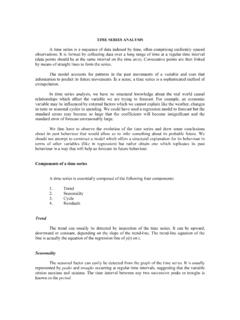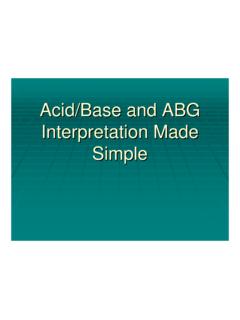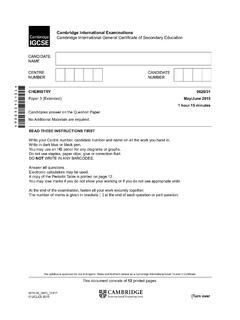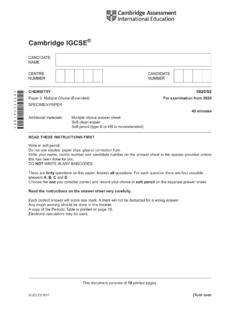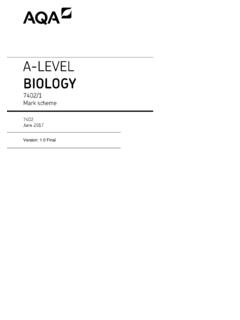Transcription of Revision notes for Chemistry O Level
1 Revision notes for Chemistry O Level TABLE OF CONTENTS 3 CHAPTER 1 The Particulate Nature of Matter4 CHAPTER 2 Experimental Techniques5 CHAPTER 3 Atoms, Elements and Compounds7 CHAPTER 4 Stoichiometry8 CHAPTER 5 Electricity and Chemistry9 CHAPTER 6 Chemical Energetics10 CHAPTER 7 Chemical Reactions12 CHAPTER 8 Acids, Bases and Salts 14 CHAPTER 9 The Periodic Table 15 CHAPTER 10 Metals 16 CHAPTER 11 Air and Water18 CHAPTER 12 Sulfur18 CHAPTER 13 Carbonates19 CHAPTER 14 Organic ChemistryPAGE 3 OF 22 PARTICULATE NATURE OF Kinetic Particle Theory When a solid is heated, particles vibrate faster about afixed point causing particles to move further apart andso solid expands When particles gain sufficient energy to overcomestrong forces of attraction, they move out of their fixedposition and can slide over each other in a continuousrandom motion solid has melted.
2 Particles in liquid have energy to move around but arestill close to each other and do not have enough energyto overcome the forces that hold them close to eachother. If more heat s supplied, particles move faster until theyhave enough energy to overcome the forces ofattraction. Particles escape the liquids surface and movearound in continuous rapid motion the liquid hasboiled In the vapor, the particles move in rapid random movement is due to collision of vapor particles withair States of Matter SOLID LIQUID GAS Strong forcesof attractionbetweenparticles Fixed pattern(lattice) Atoms vibratebut can tchangeposition fixed volumeand shape Weakerattractiveforces thansolids No fixedpattern, liquidstake up theshape of theircontainer Particles slidepast eachother. Almost nointermolecularforces Particles farapart, andmove quickly Collide witheach other andbounce in alldirectionsPROCESS HEAT ENERGY EXO/ENDOTHERMIC Melting Gained Endothermic Boiling Gained Endothermic Condensing Lost Exothermic Freezing Lost Exothermic Sublimation Gained Endothermic Reverse sublimation Lost Exothermic Heating Curve diffusion diffusion is the spreading of one substance throughanother from a region of high concentration to a regionof low concentration due to the continuous randommotion of particles.
3 Evidence for diffusion : In liquids: potassium manganate(VII) in a beaker of water In gases: a gas jar of air and a gasjar of bromine connected Factors that affect the rate of diffusion : Temperature increases rate of diffusion increases Lower density gas rate of diffusion is higherHeat increases HEAT INCREASES PAGE 4 OF 22 Measurement VARIABLE APPARATUS Time Stopwatch or Clock; Unit = S Temperature Thermomemeter (liquid in glass,thermistor or thermocouple); Unit = K Mass Balance; Unit = kgMeasuring Volume: Beaker Burette Pippette Measuring Cylinder Gas Syringe Critertia of Purity Paper chromatography:oDrop substance to center of filter paper and allow itto dryoDrop water on substance, one drop at a timeoPaper + rings = : Difference in solubility separates differentpigmentsoSubstances travel across paper at different rateswhich is why they separate into ringsoMethod works because different substances travel atdifferent levels of attraction to it Stationary phase is material on which separation takesplace Mobile phase consists of the mixture you want toseparate, dissolved in a solvent.
4 Interpreting simple chromatograms:oNumber of rings/dots = number of substancesoIf two dots travel the same distance up the paperthey are the same can calculate the Rf value to identify a substance,given by the formula: = To make colourless substances visible, use a locatingagent:oDry paper in ovenoSpray it with locating agentoHeat it for 10 minutes in oven Assesing purity from :oPure substances have a definite, sharp +impurity has lower and higher impurity means bigger Filtration Mixture goes in a funnel with filter paper, into a flask. Residue is insoluble and stays at top. Filtrate goes Crystallization Some water in the solution isevaporated so solution becomesmore concentrated. A drop is placed on a slide tocheck if crystals are forming. Solution is left to cool andcrystallise.
5 Crystals are filtered to 5 OF 22 Simple Distillation Impure liquid is heated It boils, and steam rises into the condenser Impurities are left behindCondenser is cold so steam condenses to the pure liquidand it drops into the Fractional Distillation Removes a liquid from a mixture of liquids, becauseliquids have different Mixture is heated to evaporate substance with some of the other liquid(s) will evaporate too. A mixture of gases condense on the beads in thefractional column. So the beads are heated to the boiling point of thelowest substance, so that substance being removedcannot condense on the beads. The other substances continue to condense and will dripback into the beaker can be changed after every Seperating Mixture of Two Solids Can be done by dissolving one in an appropriate solvent Then filter one and extract other from solution byevaporationIf one solid is magnetic, can use a magnet sand and iron fillings SOLVENT IT Water Some salts, sugar White spirit Gloss paint Propanone Grease, nail polish Ethanol Glues, printing inks, scented substances Choosing a Suitable Method METHOD OF SEPARATION USED TO SEPARATE Filtration A solid from a liquid Evaporation A solid from a solution Crystallization A solid from a solution Simple Distillation A solvent from a solution Fractional Distillation Liquids from each other Chromatography Different substances from a solution.
6 ELEMENTS AND Atomic Structure and the Periodic Table PARTICLE RELATIVE CHARGE MASS (ATOMIC MASS ) Proton +1 1 Neutron 0 1 Electron -1 1 1836 Proton number: number of protons in an atom (andnumber of electrons in an atom) Nucleon number: number of protons + neutrons in anatom. In the periodic tableoThe proton number increases by 1 when you go tothe rightoWhen you go one element down, you increase protonnumber by 8 in the first 3 periods (transition elementsnot included) Isotopes: atoms of same element with different no. Carbon 12 and Carbon types: non-radioactive isotopes and radioactive-isotopes which are unstable atoms that break downgiving radiationsoMedical use: cancer treatment (radiotherapy) rayskill cancer cells using cobalt-60oIndustrial use: to check for leaks radioisotopes(tracers) added to oil/gas. At leaks radiation isdetected using a Geiger 6 OF 22 Electrons are arranged in electron shells.
7 Atoms want to have full outer shells (full set of valencyelectrons), this is why they react. Noble gases have full outer shells so they have no needto react. Electron shell structure: 2, 8, 8, 18. More reactive elements have a greater desire to have afull outer shell, so also form more stable Bonding: the Structure of Matter Element: substance that cannot be split into anythingsimpler, in a chemical reaction. Each element has aunique proton number. Mixture: two or more elements mixed together but notchemically combined Compound: substance in which two or more differentelements are chemically combinedMETALS NON-METALS Strong Brittle Good conductors of heat & electricity Poor conductors of heat & electricity (except graphite) High and Lower and than metals High density Low density Forms basic oxides Forms acidic oxides Forms cations in reactions Forms anions in reactions Malleable and ductile Sonorous Some are magnetic Alloy.
8 Mixture of two or more metals or mixture of oneor more metal with a non-metal, to improve Ions and Ionic Bonds Chemical bond formed by transfer of s from one atomto another Metals lose s to form cations, non-metals gain s toform anions Positive cations & negative anions attract to each other Strong electrostatic force of attraction between positivecations and negative anions is called ionic bondingPROPERTY REASON Form giant lattice Cations and anions attract High and Strong bonds between ions Don t conduct electricity when solid Ions can t move Conduct electricity when molten/aqueous Ions can move Usually soluble in water Not required Molecules and Covalent Bonds When atoms share s to obtain a noble gas electron structure, covalent bonding arises. Covalent bonding takes place between non-metals onlySINGLE BOND DOUBLE BOND TRIPLE BOND 2 s shared (1 from each atom) 4 s shared (2 from each atom) 6 s shared (3 from each atom) PROPERTY REASON Low and Weak intermolecular forces of attraction between molecules Usually liquid, gas or low solidDon t conduct electricity No mobile ions/electrons Usually insoluble in water Not required Macromolecules DIAMOND GRAPHITE SILICON DIOXIDE Four bonds High Doesn t conduct Used for cuttingas is srongestknownsubstance Three bonds Made of flatsheets Held together byweak forces so issoft used as alubricant Conducts electricityas it has one free e- Makes up sand Each Si is bondedto 4 oxygen atoms,and each oxygen isbonded to 2 siliconatoms it has a high is hard, likediamondPAGE 7 OF 22 Melting point.
9 High - structure made up of strongcovalent bonds Electrical: don t conduct electricity - have no mobile ionsor electrons, except for graphite Strength: hard - exists in tetrahedral structure butgraphite is Metallic Bonding Positive ions held together by electrons acts like glue Balancing equations: a chemical equation is balancedwhen there are equal number of atoms and charges onboth sides of the equation State symbols:o(s) = solido(l) = liquido(g) = gaso(aq) = aqueous Valency Table NAME FORMULA VALENCY Nitrate NO3-1 Hydroxide OH- 1 Acetate/ ethanoate CH3 COO-1 Carbonate CO32-2 Sulphate SO42-2 Silicate SiO32-2 Phosphate PO43-3 Ending of Names Compound ending with -ide only contain two differentelements Compound ending with -ate contain Masses Relative atomic mass (Ar): mass of one atom of anelement relative to one twelfth of the mass of one atomof Carbon-12 Relative molecular mass (Mr): sum of relative atomicmasses of all the atoms in one molecule of The Mole Concept A mole of a substance is the amount that contains thesame number of units as the number of carbon atoms in12 grams of carbon-12 A mole is the Ar or Mr expressed in grams 1 mole ofCarbon-12 is equal to 12 grams.
10 It is equal to 1023 atoms, this number is calledAvogadro s Number of Moles = Moles in Gases = . 24 3 Concentration = . Moles per dm3o1mol/dm3 = 1M Grams per dm3, Molecular Formulae The formula using the actual number of atoms in Empirical Formulae This is the simplest ratio of the atoms in a compound For example:oMolecular formula of ethanol = C2H5 OHoEmpirical formula of ethanol = C2H6O To find out the empirical formula you:oMake the percent ratio into the simplest wholenumber ratio (NOTE: if given %s, use them as grams)oDivide the coefficients of each element symbol by thelowest Percentages = ( ) ( ) 100 = 100 PAGE 8 OF 22 AND Chemistry Decomposition of an electrolyte with the help of electriccurrent Electrolyte:oAq.


